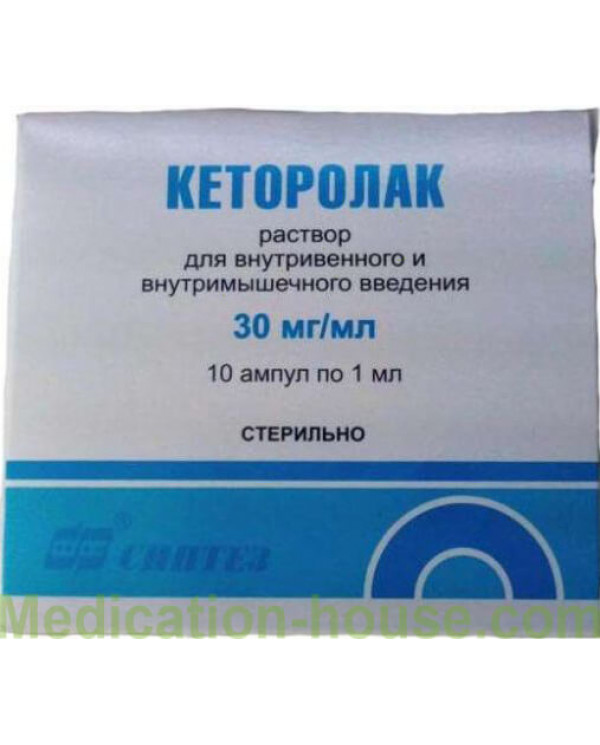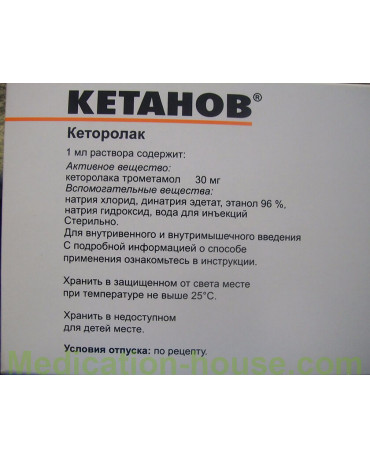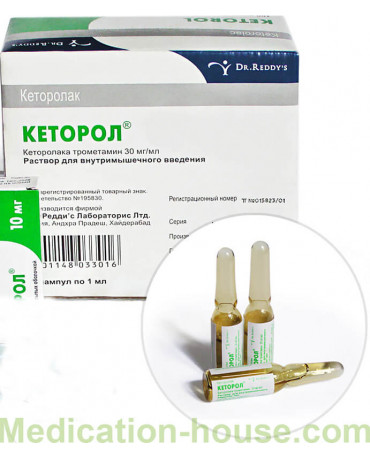Ketorolac instruction
You can buy Ketorolac injections here
Composition and properties of Ketorolac
One ampoule (1 ml) contains:
active ingredient: ketorolac tromethamine (in terms of 100% substance) - 30 mg;
excipients: sodium chloride, disodium edetate, rectified ethyl alcohol from food raw materials 96.3%, tromethamine solution 0.5 M, water for injection.
Description: A clear, light yellow liquid with a faint odor.
Pharmacotherapeutic group: Anti-inflammatory and antirheumatic products. Nonsteroidal anti-inflammatory drugs. Acetic acid derivatives. Ketorolac.
Pharmacokinetics
Absorption after i / m administration is complete and fast.
After i / m administration, 30 mg Cmax - 1.74-3.1 µg / ml, 60 mg - 3.23-5.77 µg / ml. Cmax - 15-73 min and 30-60 min, respectively.
Communication with plasma proteins - 99%.
The time to reach Css with parenteral administration is 24 hours when administered 4 times a day (higher than subtherapeutic), and when i administered 15 mg - 0.65-1.13 μg / ml, 30 mg - 1.29 - 2.47 μg / ml.
The volume of distribution is 0.15 - 0.33 l / kg. In patients with renal insufficiency, the volume of distribution of Ketorolac injections may increase by 2 times, and the volume of distribution of its R-enantiomer - by 20%.
Penetrates into breast milk: when mother takes 10 mg of ketorolac Cmax in milk is reached 2 hours after taking the first dose and amounts to 7.3 ng / ml, 2 hours after applying the second dose of ketorolac (using the drug 4 times a day) - 7 , 9 ng / l.
More than 50% of the administered dose is metabolized in the liver to form pharmacologically inactive metabolites.
The main metabolites are glucuronides. which are excreted by the kidneys, and p-hydroxyketorolac.
Excreted in 91% of the kidneys, 6% - through the intestines.
T1 / 2 in patients with normal renal function - an average of 5.3 h (3.5–9.2 h after i / m administration of 30 mg) T1 / 2 increases in elderly patients and shortens in the young. Liver function has no effect on T1 / 2. In patients with impaired renal function, when plasma creatinine concentration is 19-50 mg / l (168 - 442 μmol / l) T1 / 2 - 10.3-10.8 h, with more severe renal failure - more than 13.6 h.
The total clearance for intramuscular administration is 30 mg - 0.023 l / h / kg (0.019 l / h / kg in elderly patients; in patients with renal insufficiency with plasma creatinine concentration of 19-50 mg / l with intramuscular injection of 30 mg - 0.015 l / h / kg).
Pharmacodynamics
Ketorolac refers to nonsteroidal anti-inflammatory drugs.
It has a pronounced analgesic effect, also has anti-inflammatory and moderate antipyretic effect.
The mechanism of action is associated with non-selective inhibition of the activity of COX1, and TSOG2, which catalyzes the formation of prostaglandins from arachidonic acid, which play an important role in the pathogenesis of pain, inflammation and fever. The strength of the analgesic effect is comparable to morphine, significantly superior to other NSAIDs.
After i / m administration, the onset of the anapicantic effect is noted, respectively, after 0.5 h, the maximum effect is achieved in 1-2 h.
Indications for use Ketorolac
For short relief of pain syndrome of medium and strong intensity, mainly, with injuries, in the postoperative period, with radicular syndrome, muscle and joint pain.
Ketorolac application (method, dosage)
Intramuscularly.
For parenteral use in patients from 16 to 64 years old with a body weight exceeding 50 kg, no more than 60 mg is administered per administration for 1 administration (including oral dose); usually 10–30 mg every 6 hours.
V / m in adult patients with a body weight of less than 50 kg or with chronic renal failure for a single injection is administered no more than 30 mg (including oral dose); usually 10-15 mg every 4-6 hours.
The maximum daily doses for intramuscular administration are for patients from 16 to 64 years old with a body weight exceeding 50 kg - 90 mg / suc; adult patients with a body weight of less than 50 kg or with chronic renal insufficiency, as well as older patients (over 65 years) - for intramuscular administration of 60 mg.
For parenteral administration, the duration of treatment should not exceed 5 days.
Side Effects of Ketorolac
Often
gastralgia, diarrhea (especially in elderly patients over 65 years of age with a history of erosive and ulcerative lesions of the gastrointestinal tract);
headache, dizziness, drowsiness;
swelling (face, legs, ankles, fingers, feet, weight gain).
Sometimes
stomatitis, flatulence, constipation, vomiting, feeling of fullness in the stomach;
high blood pressure;
skin rash (including maculopapulla rash), purpura;
burning or pain at the injection site;
excessive sweating.
Seldom
nausea, erosive and ulcerative lesions of the gastrointestinal tract (including with perforation and / or bleeding - abdominal pain, spasm or burning in the epigastric region, blood in the feces or melena, vomiting with blood or like "coffee grounds" nausea, heartburn and others), cholestatic jaundice, hepatitis, hepatomegaly, acute pancreatitis;
acute renal failure, back pain with or without hematuria and / or azotemia, hemolytic uremic syndrome (hemolytic anemia, renal failure, thrombocytopenia, purpura), frequent urination, increased or decreased urine volume, nephritis, edema of renal origin;
hearing loss, tinnitus, blurred vision (including blurred vision);
bronchospasm or dyspnea, rhinitis, pulmonary edema, laryngeal edema (shortness of breath, difficulty breathing);
aseptic meningitis (fever, severe headache, cramps, stiff neck and / or back muscles), hyperactivity (mood changes, anxiety), hallucinations, depression, psychosis;
fainting;
anemia, eosinophilia, leukopenia;
bleeding from postoperative wounds, nosebleeds, rectal bleeding;
exfoliative dermatitis (fever with or without chills, redness, hardening or peeling of the skin, swelling and / or tenderness of the tonsils), urticaria, Stevens-Johnson syndrome, Lyell's syndrome;
anaphylaxis or anaphylactoid reactions (discoloration of the skin of the face, itchy skin, tachypnea or dyspnea, eyelid edema, periorbital edema, shortness of breath, difficulty breathing, chest pain, wheezing);
swelling of tongue, fever.
Contraindications Ketorolac
Hypersensitivity to ketorolac, full or partial combination of asthma, recurrent nasal polyposis and paranasal sinuses and intolerance to acetylsalicylic acid and other non-steroidal anti-inflammatory drugs (including history), urticaria, rhinitis caused by nonsteroidal antiinflammatory drugs (history) dehydration;
intolerance to drugs of the pyrazolone series, hypovolemia (regardless of the cause that caused it), bleeding or a high risk of their development, condition after coronary artery bypass surgery, confirmed hyperkalemia, inflammatory bowel disease;
Erosive and ulcerative lesions of the gastrointestinal tract in the acute stage, peptic ulcers, hypocoagulation (including hemophilia);
severe renal and / or liver failure (creatinine clearance less than 30 ml / min);
hemorrhagic stroke (confirmed or suspected), hemorrhagic diathesis, impaired blood formation;
pregnancy, childbirth and lactation;
children's age up to 16 years (safety and efficiency are not established);
pain relief before and during surgery due to the high risk of bleeding, chronic pain.
Drug interactions
Co-administration with paracetamol increases the nephrotoxicity of ketorolac.
Reception with other NSAIDs, glucocorticosteroids, ethanol, corticotropin, Ca2 + drugs increases the risk of ulceration of the mucous membrane of the gastrointestinal tract and the development of gastrointestinal bleeding.
The simultaneous appointment with anticoagulant drugs - derivatives of coumarin and indandione, heparin, thrombolytics (alteplaza, streptokinase, urokinase), antiplatelet drugs, cephalosporins, valproic acid and acetylsalicylic acid increases the risk of bleeding.
Reduces the effect of antihypertensive and diuretic drugs (reduces the synthesis of prostaglandins in the kidneys).
Appointment in conjunction with methotrexate increases hepato-and nephrotoxicity (their joint appointment is possible only when using low doses of the latter and controlling its concentration in plasma).
When administered with other nephrotoxic drugs (including gold medications), the risk of nephrotoxicity increases.
Drugs that block tubular secretion, reduce the clearance of ketorolac and increase its concentration in plasma.
Increases the effect of narcotic analgesics.
Myelotoxic drugs increase the hematotoxicity of Ketorolac injections.
The hypoglycemic effect of insulin and oral hypoglycemic drugs is increased (dose recalculation is required).
Joint appointment with valyproat sodium causes a violation of platelet aggregation.
Increases plasma concentration of verapamil and nifedipine.
Solution for injection should not be mixed in the same syringe with morphine sulfate, promethazine and hydroxyzine due to precipitation.
Pharmaceutically incompatible with tramadol solution, lithium preparations.
Ketorolac solution for injection should not be mixed in the same syringe with other drugs.
special instructions for Ketorolac injections
Before prescribing the drug, it is necessary to clarify the issue of previous allergy to the drug or other NSAIDs.
Due to the risk of allergic reactions, the first dose is administered under close medical supervision.
Hypovolemia increases the risk of nephrotoxic adverse reactions.
If necessary, you can assign in combination with narcotic analgesics.
It is not recommended to use as a drug for sedation, maintenance of anesthesia.
When taken jointly with other NSAIDs, fluid retention, decompensation of cardiac activity, and an increase in blood pressure may be observed.
The effect on platelet aggregation is terminated after 24-48 hours.
Do not use simultaneously with paracetamol for more than 5 days.
Patients with impaired blood coagulation are prescribed only with constant monitoring of the number of platelets, especially important for postoperative patients requiring careful monitoring of hemostasis.
The risk of developing drug complications increases with prolongation of treatment (in patients with chronic pain) and an increase in the oral dose of Ketorolac injections over 40 mg / day.
To reduce the risk of developing NSAID-gastropathy, antacid medicines, misoprostol, omeprazole are prescribed.
Features of the influence of Ketorolac injections on the ability to drive motor vehicles and manage potentially dangerous machinery
During the period of treatment, care must be taken when driving vehicles and engaging in other potentially hazardous activities that require increased concentration and psychomotor speed.
Ketorolac Overdose
Symptoms (with a single injection): abdominal pain, nausea, vomiting, erosive and ulcerative lesions of the gastrointestinal tract, impaired renal function, metabolic acidosis.
Treatment: symptomatic (maintaining vital body functions). Dialysis is ineffective.
Form release and packaging
1 ml in ampoules of glass.
10 ampoules with a knife or a scarifier for opening ampoules are placed in a cardboard box with a corrugated liner made of corrugated paper.
A box is pasted over with a parcel-label from a paper for multi-color printing.
The boxes, together with instructions for medical use, are packaged in bulk packaging.
The number of instructions for use must match the number of packages.
10 ampoules are placed in a liner of a polyvinyl chloride film. 1 insert with ampoules together with a knife for opening ampoules or a scarifier ampoule and instructions for medical use are put into a pack of cardboard for consumer packaging of the brand chrome-ersatz or cardboard chrome-ersatz.
10 ampoules together with a knife for opening ampoules or a scarifier ampoule and instructions for medical use are placed in a pack with a cardboard insert for fixing ampoules made of cardboard.
In the case of using ampoules with a fracture ring or with a notch and a breakpoint, an attachment of a knife or scarifier for opening ampoules is not provided.
Group packaging and transport packaging according to GOST 17768-90.
Storage conditions
In the dark place at a temperature of from 15 ° C to 25 ° C. Keep out of the reach of children.
Shelf life - 2 years. Do not use after expiration date.
Terms of sell
You don't need a prescription to buy Ketorolac.



